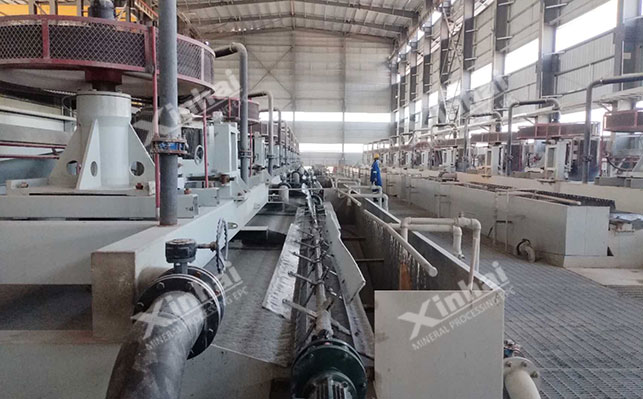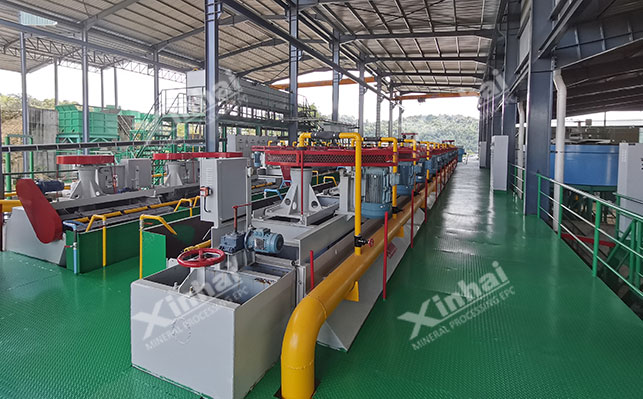
15311826613
Click to add WeChatZinc is a kind of non-ferrous metal and an important strategic mineral resource in my country. However, with the large-scale mining of easy-to-select zinc, it has been gradually exhausted, and the difficult-to-select zinc oxide has become the focus of development. Zinc oxide is a secondary mineral of zinc, and its ore types are mostly in the form of smithsonite, hemimorphite, willemite, hydrozincite, and red zincite. For this kind of zinc oxide, flotation is often used for mineral processing. Its flotation processes include sulfide-amine salt flotation, sulfide-xanthate flotation, fatty acid collector flotation, flocculation flotation, long carbon chain CH and SH group collector flotation, etc.
The sulfide-amine salt flotation process mainly uses fatty acids as collectors for zinc oxide, but amine flotation is sensitive to ore mud and soluble salts; the flotation effect is not very ideal. In addition, for zinc oxide containing a large amount of mica, sericite, chlorite, shale or carbonaceous shale in the mineral, during flotation, this type of gangue will float up with zinc oxide, affecting its concentrate grade. If you want to improve the concentrate grade, a large amount of reagent support is required. In order to reduce the dosage of reagents and improve the effect of collectors, the following measures can be taken:

Mixed amine salt with sodium sulfide: First, pre-mix sodium sulfide solution with fatty acid amine salt, acid salt or acetate solution to make an emulsion, and then add it to the slurry to complete flotation. The addition of emulsion can effectively eliminate the indispensable desludging operation in the amine method, reduce metal loss, and improve the recovery rate of zinc. It is mostly used for the flotation of smithsonite, hydrozincite, hemimorphite and willemite.
Mixed amine and sec-octyl xanthate: The two agents can be mixed to enhance the capture of difficult-to-float hemimorphite and iron smithsonite. When the flotation contains a large amount of limonite and the zinc oxide mineral contains 1/3 of iron smithsonite, the floatability of hemimorphite is poor when mixed amine is used for flotation alone; when mixed collectors are used, the recovery rate of zinc can be increased by about 5 percentage points, and the tailings grade is reduced by 1/3.
Emulsification of mixed amine with kerosene: It is to dissolve amine collectors in pine oil and kerosene, and prepare an emulsion with a weight ratio of amine 12, pine oil 4, kerosene 2, and water 73. Its capture performance is better than that of a single amine collector.
Generally, zinc oxide minerals need to be activated by copper sulfate after sulfidation before they can be recovered by xanthate flotation. Excessive sodium sulfide will prevent the adsorption of xanthate on smithsonite, which will inhibit the floatability of smithsonite. Zinc carbonate can be activated by HS- and Cu2+, and then recovered by xanthate as a collector. When the concentration of activator and collector is high, that is, the thickness of HS- and Cu2+ on the mineral surface reaches more than 40 monolayers, zinc carbonate can be effectively floated. However, this method has poor flotation effect for minerals containing a large amount of iron oxide; it is also not suitable for recovering silicate zinc minerals; and if excessive sodium sulfide is used during the flotation process, it will inhibit zinc flotation and reduce its flotation efficiency.

Fatty acid collectors can be used for direct flotation of zinc oxide ores, and can also be used for reverse flotation to improve metal recovery. Fatty acids can successfully float siliceous ores or argillaceous ores, but it is difficult for carbonate gangue minerals. This method is inhibited when used for ores with high iron content. Since the oxidation of the original zinc oxide deposit occurs in a dolomite environment, the zinc mineral has carbonate characteristics. In addition, the gangue associated with zinc oxide ores is mainly carbonate ores, followed by sulfate ores, and then sulfates and easily floating silicates.

Selective flocculation flotation can effectively recover fine-grained zinc oxide. Before flotation, the ore is selectively flocculated and emulsified and flocculants are added. For example, caustic starch is used to flocculate fine mud, so that the particle size of zinc oxide mud increases by 2 to 10 times, increasing its floatability. Then a certain amount of mercaptocarboxylic acid is used as a collector for zinc oxide minerals for flotation, which can be suitable for the flotation of zinc oxide minerals such as smithsonite, hemimorphite, and hydrozincite, with good results.

Long carbon chain CH and thiol-based SH flotation uses high-grade thiol as collector to flot smithsonite and hemimorphite; in addition, pentadecyl mercaptan can be used as collector and tannin as inhibitor to float zinc oxide ore, but the agent has a weaker ability to collect quartz.

The above is an introduction to several common zinc oxide ore flotation processes. In actual ore dressing plants, the ore properties of zinc oxide are complex, and the types of minerals contained are different. Therefore, the process scheme cannot be selected blindly. It is recommended to conduct ore dressing tests first, and design a suitable zinc oxide selection process scheme through experimental analysis.
In addition to flotation, zinc oxide ore can also be selected by leaching method. Please look forward to its content introduction!